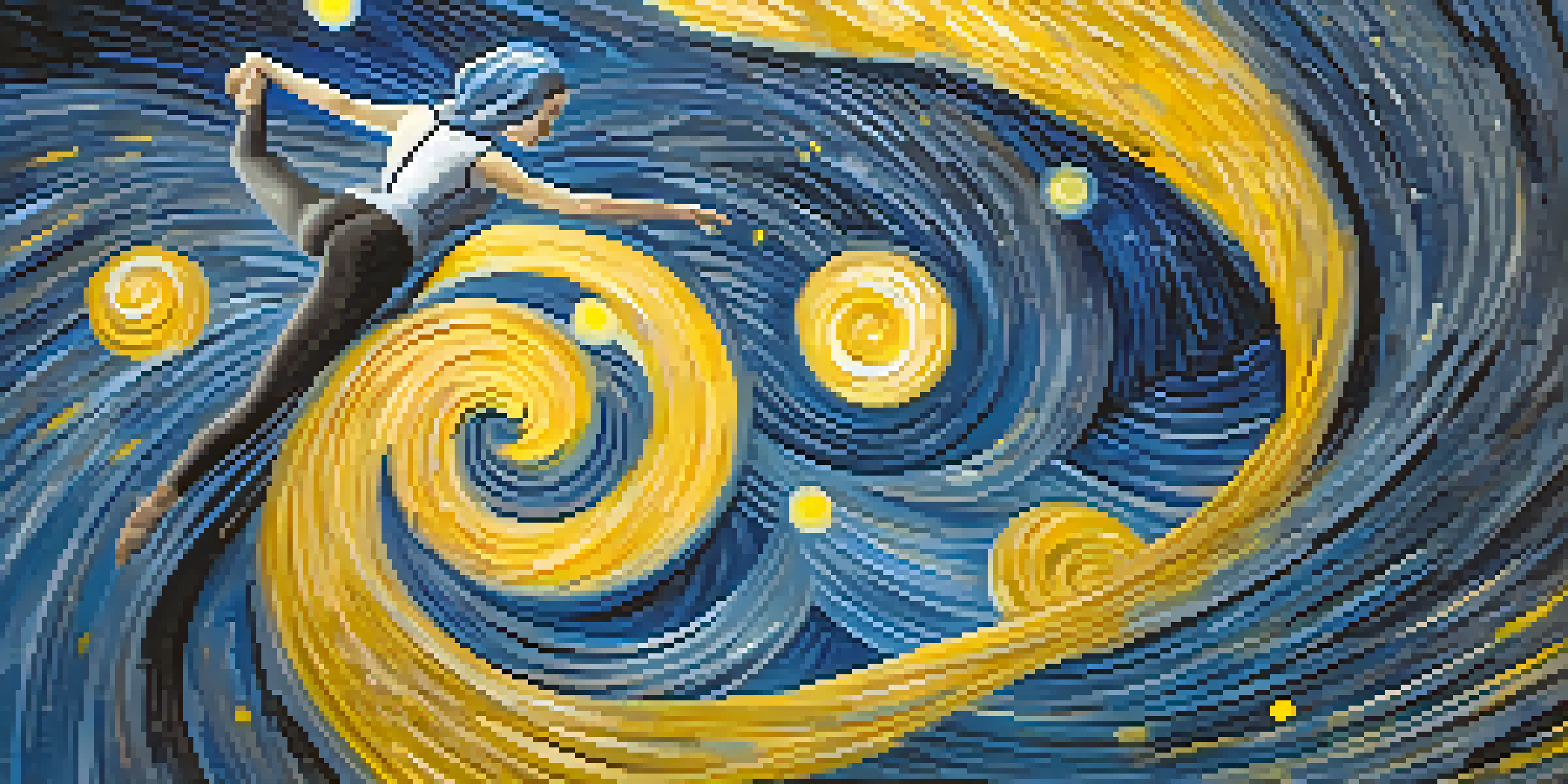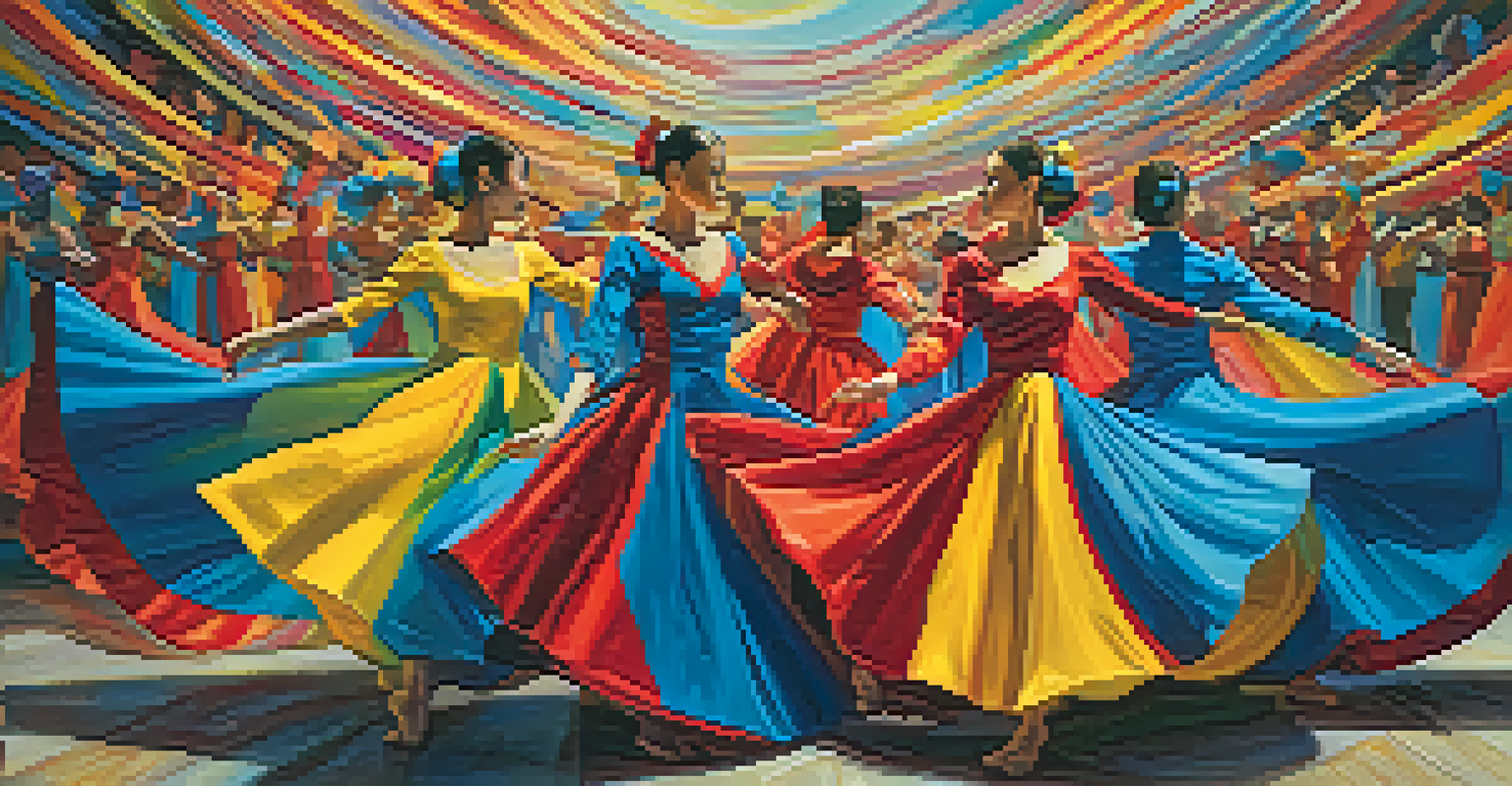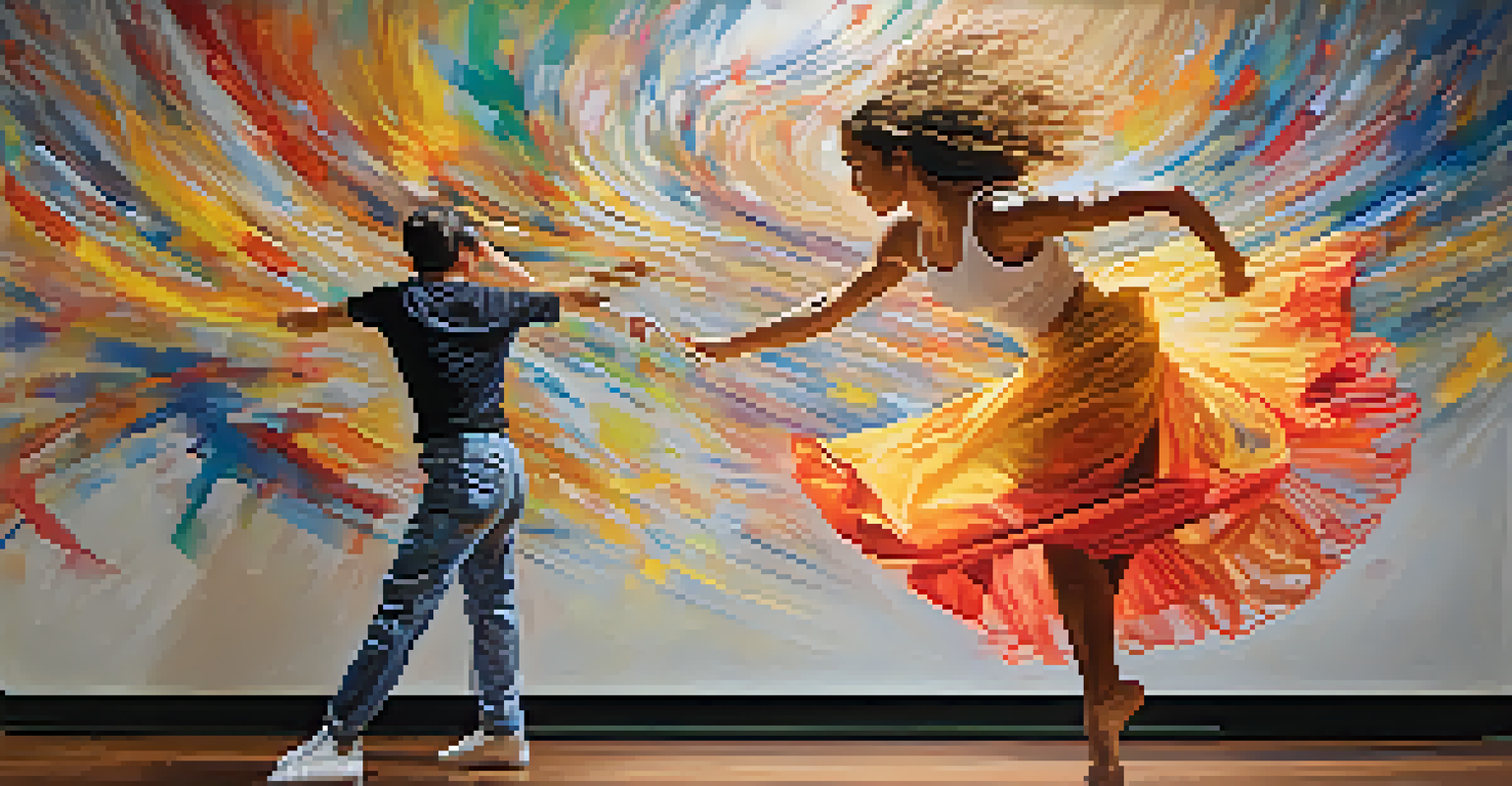Movement Interpretation: Dancers Responding to Paintings

The Art of Movement: A Unique Dance Experience
Movement interpretation bridges the gap between visual art and dance, inviting performers to embody the emotions and stories behind paintings. This transformative process allows dancers to explore the narrative of a piece, giving life to colors and shapes through their movements. Each dancer’s interpretation can vary widely, reflecting personal experiences and feelings that resonate with the artwork.
Dance is the hidden language of the soul.
For example, a dancer might respond to the swirling patterns of Van Gogh's 'Starry Night' with fluid, spiraling movements, evoking the chaos and beauty of the night sky. This unique blend of disciplines fosters a deeper understanding and appreciation of both art forms, as viewers witness how movement can enhance the emotional depth of a painting. The result is a powerful synergy that captivates audiences and enriches the cultural landscape.
Moreover, the process encourages collaboration between dancers and visual artists, often leading to innovative performances that challenge traditional boundaries. By engaging in this dialogue, dancers not only showcase their interpretation but also invite viewers to participate in a shared experience, prompting them to reflect on their own perceptions of art.
Historical Roots of Dance and Visual Art Interactions
The relationship between dance and visual art has deep historical roots, tracing back to ancient cultures that celebrated movement in conjunction with artistic expression. From ritualistic dances that honored deities to performances inspired by classical sculptures, this interplay has been a vital part of human creativity. Artists like Martha Graham and Merce Cunningham have paved the way for contemporary interpretations of art through dance.

In the 20th century, the rise of modern dance introduced new ways for performers to interact with visual art. Choreographers began to draw direct inspiration from paintings, sculptures, and installations, creating works that reflected the essence of these pieces through movement. This evolution highlights the ongoing dialogue between disciplines, emphasizing how each can inform and elevate the other.
Dance Enhances Visual Art Experience
Movement interpretation allows dancers to embody and express the emotions of visual art, creating a deeper connection between the two forms.
As we delve into this historical context, it becomes clear that the fusion of dance and visual art is not merely a modern phenomenon but rather a continuation of a rich tradition. This legacy inspires today’s artists to experiment and innovate, ensuring that movement interpretation remains a dynamic and evolving practice.
Key Elements of Movement Interpretation
Movement interpretation encompasses several key elements that dancers consider when responding to visual art. First and foremost is the emotional response, as dancers tap into their feelings about the artwork to convey its essence through their movements. The second element is the physicality of the piece, where dancers analyze colors, forms, and textures to inform their choreography.
Art is not what you see, but what you make others see.
Additionally, timing plays a crucial role, as dancers often choose to synchronize their movements with the rhythm and flow of the artwork. This could mean adjusting their pace to match the dynamic energy of a painting or using stillness to create a moment of contemplation. By weaving these elements together, performers craft a narrative that resonates with both the art and the audience.
Finally, the use of space is paramount in movement interpretation. Dancers must consider how their bodies interact with the environment, often transforming spaces into extensions of the artwork itself. This spatial awareness allows them to create an immersive experience that captivates viewers and invites them to see the artwork in a new light.
The Role of Emotion in Dance Interpretations
Emotion serves as the heartbeat of movement interpretation, guiding dancers to communicate feelings that may be implicit in a painting. When a dancer stands before a piece, they often experience a visceral reaction that informs their movements. This emotional connection can range from joy and excitement to melancholy and reflection, allowing for a rich tapestry of expression.
For instance, a dancer interpreting Edvard Munch's 'The Scream' might channel feelings of anxiety and isolation through sharp, erratic movements. The potency of this emotional response not only enhances the performance but also invites the audience to engage with the artwork on a personal level. Viewers may find themselves reflecting on their own emotions and experiences as they witness this dynamic exchange.
Collaboration Fuels Artistic Innovation
The partnership between dancers and visual artists leads to innovative performances that challenge traditional boundaries and enhance the creative process.
Moreover, this emotional depth fosters a sense of vulnerability between the dancer and the audience. When performers share their raw feelings, it creates an authentic connection that transcends language and speaks directly to the human experience. This exchange is what makes movement interpretation a powerful form of storytelling.
Collaboration Between Dancers and Visual Artists
Collaboration is at the heart of movement interpretation, bringing together the unique perspectives of dancers and visual artists. This partnership often begins with dialogues about the artwork, where dancers gain insights into the artist's intentions and the emotions behind the piece. By understanding the narrative, dancers can create more informed and resonant interpretations.
In some cases, visual artists may even create new works specifically for a dance performance, allowing both art forms to evolve in tandem. This collaborative approach not only enriches the creative process but also encourages experimentation and innovation. The result is often a breathtaking fusion of movement and visual aesthetics that captivates audiences.
As these collaborations unfold, they challenge traditional notions of both dance and visual art, pushing the boundaries of what each discipline can achieve. This synergy fosters a vibrant artistic community, where ideas flow freely and inspire new ways of thinking about art and expression.
Examples of Successful Movement Interpretations
Several notable performances have exemplified the power of movement interpretation, showcasing how dancers can breathe life into visual art. One such example is 'The Dance of the Statues,' where dancers interpreted classical sculptures through graceful movements, creating a living gallery that mesmerized audiences. Each dancer embodied the essence of a statue, highlighting the intricate details and emotions captured in the original artwork.
Another inspiring performance is 'Color in Motion,' where dancers responded to abstract paintings by using vibrant colors in their costumes and movements. This creative approach transformed the stage into a visual feast, compelling viewers to experience the artwork from a fresh perspective. The interplay of color and movement sparked conversations about the relationship between art and emotion.
Future of Art Intersects with Technology
Emerging technologies like virtual and augmented reality are set to revolutionize movement interpretation, offering new ways for artists to collaborate and engage audiences.
These performances not only entertain but also provoke thought and discussion about the connections between different forms of artistic expression. They serve as reminders that movement interpretation is more than just a performance; it's a celebration of creativity that invites audiences to engage with art in new and exciting ways.
The Future of Movement Interpretation in Art
As the worlds of dance and visual art continue to intersect, the future of movement interpretation looks bright and promising. Emerging technologies, such as virtual reality and augmented reality, offer exciting new avenues for collaboration, allowing artists to push the boundaries of traditional performances. Imagine dancers interacting with digital art projections, creating an immersive experience that transports audiences into a different realm.
Furthermore, the increasing emphasis on interdisciplinary art forms encourages artists to explore innovative ways of blending movement with visual art. This trend fosters an environment where creativity thrives, and artists from diverse backgrounds come together to share their unique perspectives. As a result, we can expect to see even more dynamic performances that challenge our understanding of both dance and visual art.

Ultimately, the evolution of movement interpretation will continue to reflect the changing cultural landscape. As new generations of artists emerge, they will undoubtedly bring fresh ideas and inspirations, ensuring that this vibrant practice remains relevant and engaging for audiences worldwide.